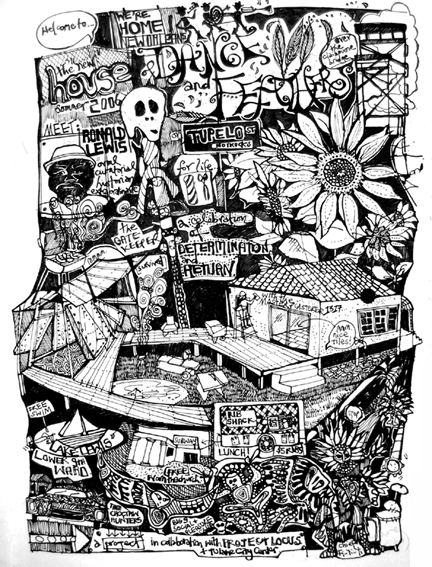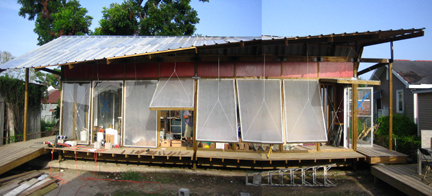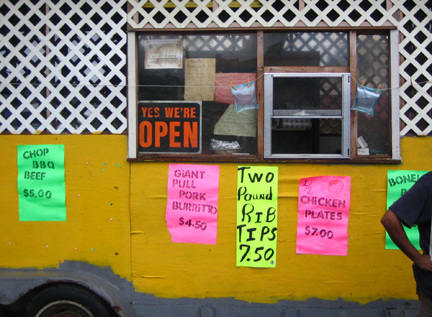First there was the Bring New Orleans Back plan that Nagin overturned upon his re-election (after grandiose ideas were rejected by Congress, after FEMA money failed to materialise, after protests from local groups). Next there was the Lambert-Danzey planning process, orchestrated by the City Council, which basically circumnavigated the mayor's office. Now the Unified New Orleans Plan, funded by the Rockefeller Center, is thrusting that process out the way so that an ‘official’ Grand Plan can be finalised by the end of the year. Each neighbourhood will be assigned (sorry, vote for…) a planning team, and organisers are promising to synthesise the process with the grassroots, self-organised planning that most districts have already initiated.
Two important meetings of the Unified New Orleans Plan took place while I was in the city. There are lots of disgruntled, eloquent blogs that have already documented the democratic charade that invited all residents of the city to vote from a preselected pool of planning teams, after a series of 12 minute presentations, in a room designed to hold 300 (plans to get the Superdome fell through apparently). Link to
People Get Ready,
Becky Houtman and
Darwin BondGraham for their relative ironic/earnest/sour takes on it, as well as this genius diagram by
Toulouse Street.
I can’t imagine any citywide planning process that could possibly run smoothly under the given circumstances but nonetheless Tuesday 1st August was definitely a reason to feel pessimistic about official efforts to co-ordinate the city’s future. With twelve precious minutes in which to sell themselves most teams did a dismal job. Carol and I were rolling our eyes back in our heads by number eight (there were eighteen in total) and we have some ability to read drawings and understand planning language. Screen after screen of tedious bullet points about relevant expertise or predetermined processes. Irritating slogans with bad graphic effects. Illegible diagrams of teams organised into hierachical boxes. Vague drawings from other projects with lots of nice, green trees. Slides of half empty meeting rooms with whiteboards and neatly dressed ‘facilitators’ wielding sharpie pens as demonstrations of inclusive methods - just what the ‘charette weary’ residents of the city want to see I’m sure. Powerpoint - surely the most disastrous thing that ever happened for civic engagement?

If teams were local they laboured on it, if they weren’t they went to pains to parade the member of the team who had been born there. There were lots of emotional dedications to the ‘unique spirit’ of New Orleans. Frederic
"The Man who Listened" Schwartz had clearly been rehearsing for days, turning bright red as he lyricised
“if you’re from updown, downtown, backwater, bywater, lower ninth, upper ninth…we are here for YOU”. Large
, bouncer-type men were introduced as ‘implementation strategists’,
‘this is the man who knows how to get the money’.
And the most refreshing speaker by far? Andres Duany of the Congress for New Urbanism, the devil of style over substance, server of thinly veiled real estate interests, magician of pastiche and nostalgia. He spoke simply and directly to the audience with no Powerpoint, immediately creating a more sincere and intimate connection with the audience. He touched on everything people care about – getting things done quickly, holding FEMA accountable. He waved around documents of work he had already done in Mississippi adopted by the Governor. He invited people to go to the River Ranch development a couple of hours away to see their previous work (I looked it up later – a 300 acre "re-creation of historic residential New Orleans", complete with areas named the 'French Quarter' and 'Garden District' and homes starting at $265 000). His smooth delivery was interrupted only when a member of the audience started to yell accusations of hypocrisy, the details of which were drowned out by a rabble of ‘shut ups’ and ‘shhhhshs’. I am not a fan of New Urbanism, but had I been an ordinary resident deciding on those presentations alone I probably would have voted for him.

Ronald Lewis was my only substantial connection in New Orleans to a resident whose home had been destroyed by Katrina. He is unequivocal in his distrust and disillusionment with the city planning process.
“No more dots” he kept saying, referring to the little stickers that he has put on endless maps at endless meetings to indicate where a school or firestation might go. At a UNOP meeting, he caused a stir by telling the facilitator that he could do her job,
“I can get up there and ask you what you want and write it down on a list”. Ronald is understandably suffering ‘charette fatigue’. He refused to vote for a planner at the Tuesday meeting because he refused to make an uninformed vote. And he doesn’t believe it would have made a blind bit of difference anyway.
In this broader context it’s interesting to consider the politics of the House of Dance and Feathers, whose opening was on Saturday. Ronald should be moving back into his home of twenty nine years as I write this, just before the one year anniversary of Katrina. The goal of renovating his house and building his museum anew (made possible with a grant from the Englehart Foundation and channelled through the Tulane School of Architecture) (see post below) was to generate grassroots energy and action in the neighbourhood, and in doing so to attract the attention of the media and the city at large.
The event on Saturday night was packed with Ronald’s extended family, local residents like Mr Gettridge (the 83 year old ‘master plasterer’ who is currently renovating his house on the neighbouring block by himself), Tulane students and faculty, the New Orleans media, the editor of the Times Picayune selling his latest book,
Breach of Faith. Guests ate barbeque and drunk Budweisers, and the mood was celebratory and optimistic. In Ronald’s speech he said
“if this was just about Ronald Lewis it wouldn’t be interesting…but it’s not…it’s bigger than that…it’s about people working for people”. Because Ronald is a trusted and long-term community activist these words were actually meaningful.
The House of Dance and Feathers is a symbol of hope, a catalyst for action and a means to nurture one of New Orleans most unique cultures, the Mardi Gras Indians. But could it have ever materialised within the context of the city-led planning process? I doubt it. It couldn’t have happened because it is built on private land and making extra funds available for one resident’s personal vision would be unfair in a process endeavouring to be equitable and democratic. The paradox is that because of the respect and trust Ronald commands in the Lower Ninth Ward, the ‘private development’ is likely to have wider, positive effects beyond the bounds of 1317 Tupelo Street. It is public in that it is ‘open to the public’, but in code terms it is a private garden shed. In organisational terms Ronald describes it as a ‘dictatorship’. He makes the decisions, he owns the building. And for this reason it will probably prove far more sustainable than a new neighbourhood community center with an elected committee at its helm. Here, in this situation, planning and participation theory falter….there is no accurate way to abstractly describe the sense that this particularly undemocratic renewal strategy makes.


No-one disputes that New Orleans is a unique city. But who gets to represent the essence of New Orleans and decide how to preserve it? Andres Duany builds a development that mimics the French Quarter and acts as though the soul of New Orleans is found exclusively in its architectural details and thus restored through them. Ronald can now be found daily at his museum, telling the stories of the Mardi Gras Indians and working on costumes for the first post-Katrina parade of the Big Nine Social and Pleasure Club in December. He will tell you that New Orleans is about its people... probably about how the competition between tribes at the Mardi Gras parades gives him enough stories to last all year until the next one. The new structure is a roof under which to nurture their values, struggles, stories and strength. I don’t think that Ronald’s project is the all-encompassing answer to the planning process. At the same time I do believe it represents a type of project that will squeeze through the cracks and take place in spite of, rather than because of, the official planning process, and in doing so help generate the much-needed vitality, optimism and mental strength that is needed to get the city back on its feet.
On Sunday I danced in the lot next to St Augustine Church, the oldest African American church in the city and opposite the Backstreet Cultural Museum. The bi-weekly celebrations are an energetic assemblage of old and young, black and white, drum circles and brass bands, Chief Fi Yi Yi and other Mardi Gras Indians. I thought of those slides of empty meetings, whiteboards and sharpies, and decided the official planners could do with spending half an hour at St Augustine and the House of Dance and Feathers if they need some new ideas about what really motivates the citizens of New Orleans to ‘participate’.










